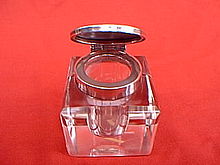


Aninkwell is a small jar or container, often made of glass, porcelain, silver, brass, or pewter, used for holding ink in a place convenient for the person who is writing. The artist or writer dips the brush, quill, or dip pen into the inkwell as needed or uses the inkwell as the source for filling the reservoir of a fountain pen. An inkwell usually has a lid to prevent contamination, evaporation, accidental spillage, and excessive exposure to air. A type known as the travelling inkwell was fitted with a secure screw lid so a traveller could carry a supply of ink in their luggage without the risk of leakage.
The inkwell's origins may be traced back to Ancient Egypt where scribes would write on papyrus. Knowledge of hieroglyphs was at the time highly restricted. Only scribes knew the full array of hieroglyphs and would write on the behalf of their employers, usually the pharaoh. After Rome invaded Egypt, inkwells became more popular in Italy as a larger percentage of the population were capable of writing.[1]
Inkwells gradually fell out of use in the early part of 20th century[2] as the reservoir fountain pen (which needs to be filled only occasionally) replaced the dip pen, which needed to be dipped in ink after writing a few lines. Old school desks had round holes for inkwells.[3]